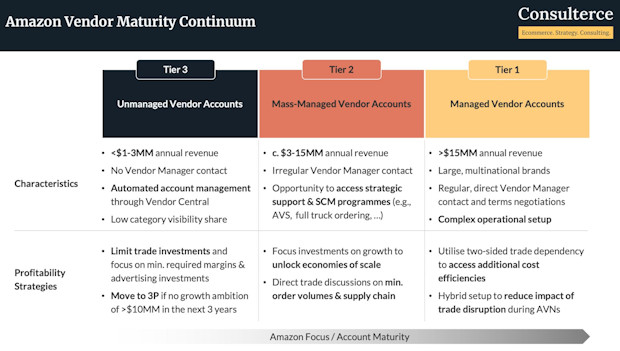By Martin Heubel, Amazon Strategy Consultant at Consulterce
You may be using strategies that don’t match your maturity level with the online retailer.
Let’s face it, not every brand is created equal:
- Some are category leaders.
- Others are rising stars.
- Some are ‘stuck’ in the middle.
But here’s the thing:
Your maturity level has direct implications on how Amazon is going to manage your vendor account!
Which is especially important to consider when preparing for your upcoming annual negotiations.
So let’s take a closer look at each maturity stage:
Tier 3: Unmanaged Vendor Accounts
Brands with less than $1-3m in annual sales are largely unmanaged by Amazon. The online retailer does not assign manual resources to these accounts and instead supports you through the case system in Vendor Central.
If you want to improve your margins, you can focus on growth initiatives to reach the next maturity stage and access more attractive economies of scale.
However, Seller Central may be a viable alternative if you cannot grow to at least $10m in the next three years or do not retain any margins.
Tier 2: Mass-Managed Vendor Accounts
Vendors in this maturity stage typically have a dedicated account or Vendor Manager.
Brands are eligible for strategic support from Amazon Vendor Service and can also take advantage of some of Amazon’s supply chain programmes.
You can improve vendor margins by entering trade negotiations with your account manager, but you’ll have limited influence over enforcing your desired terms.
Tier 1: Managed Vendor Accounts
Most multinationals fall into this category. In this stage, you can access the full bandwidth of cost-saving initiatives and run a complex operational setup with the online retailer.
Your best chance of increasing margins is to use your leading position in the category to negotiate terms and focus on distribution control.
If you regularly face sales interruptions due to Amazon suppressing or stopping orders, a hybrid setup via 3P can reduce your 1P dependency and improve your margin outlook mid-to-long-term.





